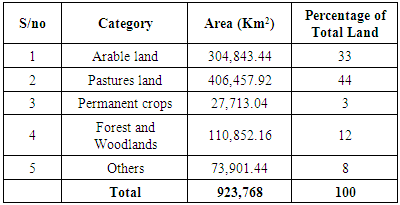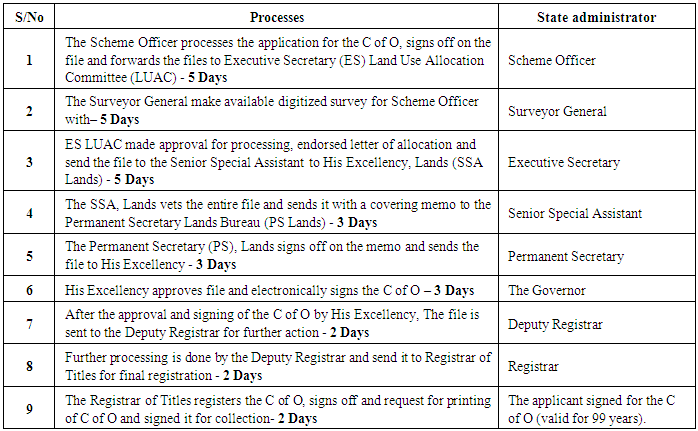-
Paper Information
- Paper Submission
-
Journal Information
- About This Journal
- Editorial Board
- Current Issue
- Archive
- Author Guidelines
- Contact Us
American Journal of Geographic Information System
p-ISSN: 2163-1131 e-ISSN: 2163-114X
2017; 6(5): 178-186
doi:10.5923/j.ajgis.20170605.02

Land Administration Domain Model in Review towards the Adoption as a Reference Model for Land Administration System in Nigeria
Babalola Sunday Oyetayo1, 2, Abdul Rahman A.1, Choon L. T.1, Idowu T. O.2, Abidoye A. I.3
1Faculty of Geo-information and Real Estate, Universiti Teknologi Malaysia, Malaysia
2Department of Surveying and Geoinformatics, Federal University of Technology Akure, Nigeria
3Faculty of Evronmental Design and Management, Obafemi Awolowo University, Ile Ife, Nigeria
Correspondence to: Babalola Sunday Oyetayo, Faculty of Geo-information and Real Estate, Universiti Teknologi Malaysia, Malaysia.
| Email: |  |
Copyright © 2017 Scientific & Academic Publishing. All Rights Reserved.
This work is licensed under the Creative Commons Attribution International License (CC BY).
http://creativecommons.org/licenses/by/4.0/

LADM covers the relevant information identified with the parts of land administration together with those over water and components beneath the earth surface. The standard provides a unique conceptual model together with three packages and sub-package. It is characterized terminologies for land administration system that allows a common portrayal of various informal standard or formal tenures. The standard additionally offers the establishment for regional and national profiles and permits the mix of land management information from different sources in an articulated manner. Given this, this study began with the depiction of land and land administration in Nigeria. The dialog of the pre-Colonial, Colonial and post-Colonial period and the hierarchical structure is important in order to exhibit an understanding foundation of the improvement required for LADM adoption in Nigeria. LADM and the packages were discussed and appraisal of the diverse elements of each class and packages was made with Nigerian land administration. In the comparison made, it was discovered that the model (LADM) could be effectively embraced into Nigerian land administration. As per this study, the terminologies used are not absolutely the same as a rule, but rather new one might be presented and fittingly clear in a version. The conclusion is that LADM can be adopted by mapping a portion of the ideas of LADM standards into Nigerian land administration system.
Keywords: Land Registration, LADM, Land Administration, Land Reform, Land Use Act, Packages
Cite this paper: Babalola Sunday Oyetayo, Abdul Rahman A., Choon L. T., Idowu T. O., Abidoye A. I., Land Administration Domain Model in Review towards the Adoption as a Reference Model for Land Administration System in Nigeria, American Journal of Geographic Information System, Vol. 6 No. 5, 2017, pp. 178-186. doi: 10.5923/j.ajgis.20170605.02.
Article Outline
1. Introduction
- Land administration framework began in Nigeria before the colonial time. Generally, the pre-colonial land administration and the cadastral framework was portrayed by the allocation and settling of the might of fighting, ruler ship in which King and warlord cut out regions for their blossoms [1]. The family and their supporters possessed the territory cut out for them; the land was used for brushing and cultivating purposes to stamp the start of land administration prior before the colonial time. In this manner, lands are claimed by the groups, towns, and families. The individual is having usufructuary rights because they are individuals from the community, which is stretched out to their family. The boundary of the land is dictated by the characteristic components, for example, a tree for every community or family. The circumstance in the northern part of Nigeria was unmistakable from the southern part. The Fulanis are the catle rarer. They take their cattle over an immense land and make their settlement without portraying the boundary and the limit of the territory. The Emirs have the outright title to land after the war as settled by the emirates. Nigeria is situated between 4°-14°N and longitude 2°-15°E [22] in West Africa with 36 States and the Federal capital region, Abuja. There are more than 400 unique dialects, 774 nearby Government and 250 ethnic talking gathering. The whole nation was divided into six Geopolitical Zone used for arranging and political representative. The land administration practise in every area and State of the same geopolitical Zone is firmly related because of their geo-political combination and connection [3]. The land administration framework transformed and experienced rebirth of birth and resurrection throughout the years in many developed, undeveloped and developing nation. Nigeria, a developing nation additionally advances in her land administration system. It was intended to help dealings in the privileges of individuals, formal and informal individual, urban and provincial society in association with the land. The information associated with the land matter (accessible control and the control association with the end goal of the new overview) was additionally made accessible to everybody interfacing with the land exchange whenever. Appropriate to this information gives the security to the matter of lands and offers the chance to distinguish the deals [30]. The (FIG) International Federation of Surveyors representing the welfares of Surveyors around the world, in 1994 approved the FIG Commission 7 to work out the vision for future cadastre framework (Cadastre 2014, FIG1998) [13]. The improvement practice of cadastre 2014 begins the start of (CCDM) Core Cadastral Domain model and (LADM) Land Administration Domain Model [8], [34]. LADM was distributed on December first, 2012 by International Standard Organization ISO19152:2012 [9] and [32]. LADM was intended to help the improvement of the application programming and the nature of data in data management framework. It is an extendable, viable and productive International standard which had some expertise in different nations to build up their packages of LADM. This study began with a presentation of the land administration framework in the study range and its portrayal. Section 2, talked about the outline and improvement of LADM with early work done by the pioneers and the specialists. Section 3 talked about the land administration framework, Land Use Act of 1978, the impact of the colonial time, the insufficiencies of the Land Use Act and the requirement for the change. Section 4, examined LADM packages to sum things up, and its pertinence in the land administration framework, in section 5, the significance, connections, and fluctuations amongst LADM and Land Administration system of Nigeria was distinguished. Section 6 of this investigation is on the forthcoming works and conclusion.
2. Historical Evolution of LADM (ISO 19152:2012)
- The adventure to LADM began with the Ph.D. thesis of Christiaan Lemmen with the essential goal to create LADM [17]. The possibility of LADM came up in 2002 at Washington DC amid FIG Congress to plan LADM. From that point forward, there are various examinations relating straightforwardly or in a indirect way to LADM. [31], did an investigation on the approval of LADM in Indonesia by showing and contrasting it and comparable recreation demonstrate and suggested the approval in another nation to make usage of LADM International worthy. He inferred that the reception of LADM into Indonesia land administration was in fact conceivable by changing the current data show into the LADM. Notwithstanding, Annex An of the Final Draft International Standard (FDIS) determines how to test a specific application blueprint whether is adjusted to LADM in packages and level. Testing a specific data set suggested that the data set substance as against the comparing data set fit in with LADM application diagram [9]. As per [17], the model must be conceivable to be used as the essential reference show and be locally and International accepted in the land administration framework. [28], proposed an approach when contrasting cadastral administration framework in view of the ISO 19152 particularly between Quebec (Canada) and Alsace-Moselle (France) apartment suite units. The study talked about the points of interest, the impediments and offered guidance to deliver a similar investigation for other cadastral frameworks. The standard arrangement of idea and terms as proposed by LADM enables the writers to measure the similitudes the distinctions, and possibility moved towards the making of coordinating record between the two frameworks. In any case, the initiator reasoned that time is expected to comprehend the documentation as some LADM classes and packages are as yet hard to coordinate the two frameworks. While breaking down the potential outcomes of connecting the land registers and other authority registration in the Republic of Croatia in light of LADM, [21] gave recommendations on how the adequacy of the registers can be expanded by connecting with LADM in the wake of directing utilizing diagram coordinating. The authors recommended the use of this study to make a procedure for enhancing the adequacy of the general procedure of the registers to enhance the monetary advance of the Republic of Croatia. [16], proposed the change of the Korean LADM nation profile to construct a 3D cadastral model. The authors use a cadastral resurvey shape, of 3D physical property representation and 3D rights. Having created Korean LADM nation profile since 2012 inferred that, the new 3D form the nation profile would be for the cutting edge in Korea. In a guide to embrace the LADM in cadastral information frameworks by [14], the investigation created an all-encompassing perspective and an essential thought for the execution of LADM. The study uncovered the institutional plan, authoritative inspiration, administration and limit building. Thus, LADM standard has been considered by various nations to receive it to their local needs in land administration system [33] and [27]. LADM was connected in Europe for Infrastructure Spatial Information (ISI) to demonstrate the similarity with INSPIRE. Moreover, examinations were done to the joining of LADM with Land Parcel Identification System (LPIS) [26]. The United Nations Committee of Experts on Global Geospatial Information Management (UN-GGIM), the Government of Ethiopia and the United Nations Economic Commission for Africa (UNECA), met the fourth Forum on United Nations Global Geospatial Information Management at UNECA's in April 2016. The subject of the gathering was ''Good Land Governance for the 2030''. The Forum take steps to create and settle on an arrangement of key geospatial information components for land administration as a subset of the UN-GGIM basic data topics lined up with the SDG worldwide marker structure, considering ISO 19152:2012. Land Administration Domain Model and advance in multi-dimensional cadastre and city models [11]. The major data structures that were used by the SOLA programming are additionally in light of the LADM which was formally propelled at the 25th FIG Congress of twentieth June 2014 in Kuala Lumpur, Malaysia [10]. Some prominent chips away at LADM by the academician and analyst from 2012 and 2015 incorporates; [2, 4-6, 12, 14, 15, 23, 25, 29, 33, 36, 37, 39] and others.
3. The Nigerian Land Administration System
- Nigeria 0ccupied 923,768 km² on the shoreline of West Africa as in the table beneath demonstrating that the land is the essential resource of county Nigerians with more than 80 percent being full-time agriculturists.
|
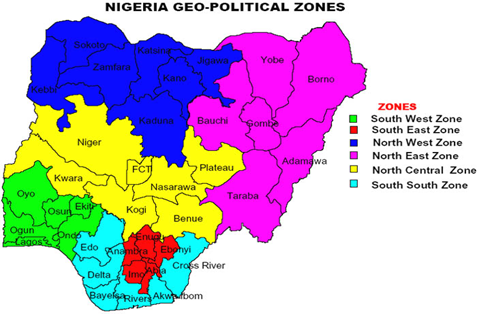 | Figure 1. Map of Nigeria [3] |
4. LADM Packages
- The three packages of LADM with one sub package is as follows;Party Package, Administrative Package, Spatial Package.(Surveying and Representation sub-package) [19]. Over viewing LADM packages, its core classes and present land administration system in Nigeria, LADM been an International standard ISO 19152 2012 provides an abstract conceptual reference model of packages linked to the people, parties, and organizations [17-19, 35]. Basic administrative units Rights, Restrictions and Responsibilities (RRR): Utility networks, spatial units, the building legal space, and parcel. Spatial sources surveying and spatial representations (geometry and topology).
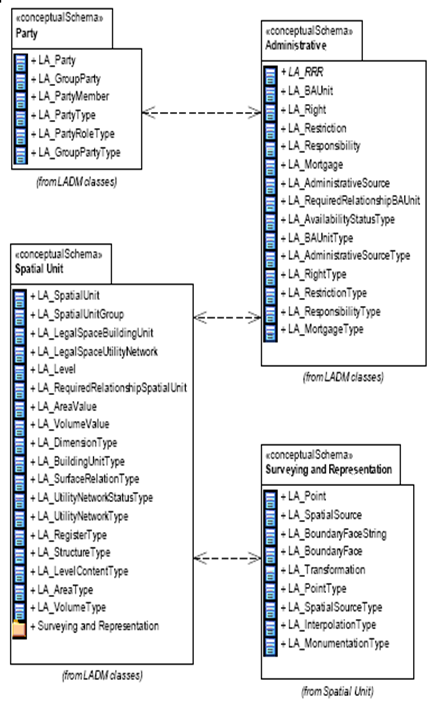 | Figure 2(a). The Basic classes LADM and NG_Prefix Proposed: [17] |
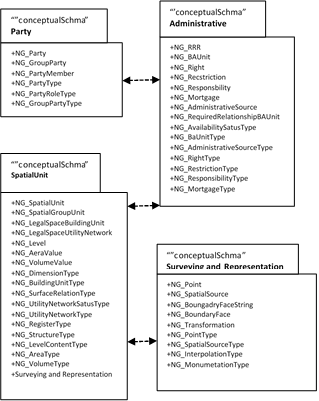 | Figure 2(b). The Basic classes LADM and NG_Prefix Proposed: [17] |
5. The Possibilities of LADM Adoption in Nigeria
- Validation can be the comparison between the real system when takes the form of comparison with the historical data when the actual system does not exist [31]. In another word, there is no existing formal model in the case of the Nigerian system, but the comparison was made based on the physical content of the land administration system in Nigeria.A Party can be identified as a natural or non-natural person(s) in the title deed of the cadastral and land registration system in Nigeria. Also, the GroupParty and PartyMember can be identified [17]. Therefore, the NG_ prefix can be proposed for the classes in Party Package for the Nation's profile (NG_PartyMember NG_GroupParty and NG_Party). Another Party identified in the process to obtain the Certificate of Occupancy (C of O) is in the land registration in Nigeria. The Governor or the Commissioner for lands apart from the Ownership, Registered Surveyor or a Lawyer as the case may be is further identified as shown in figure 2 and figure 3. Legal, administration and the technical were also identified in other documents in land administration. The attributes in this package may be precisely applicable in the land administration system in Nigeria.
|
|
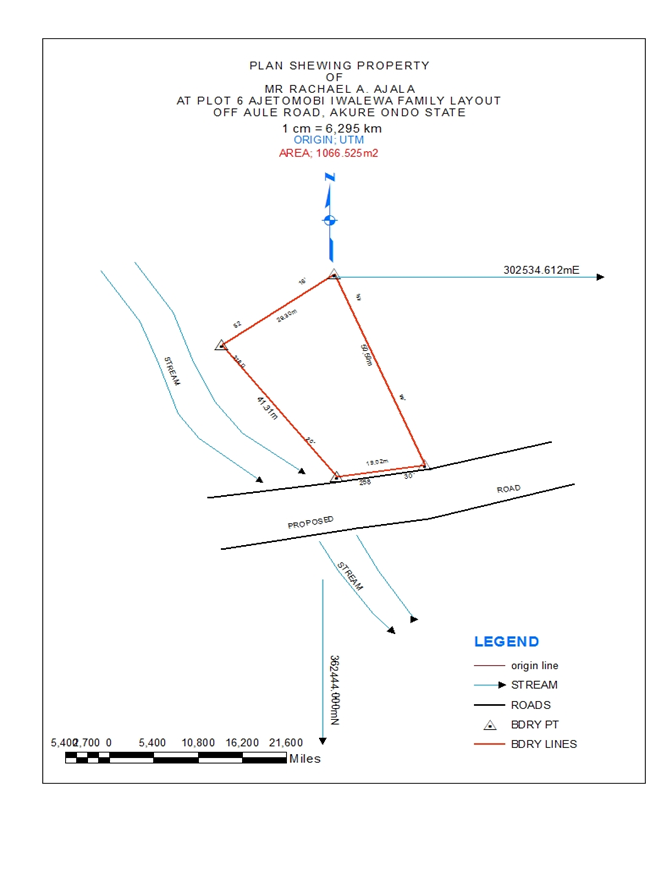 | Figure 3. Source document (Nigerian Typical cadastral Plan) |
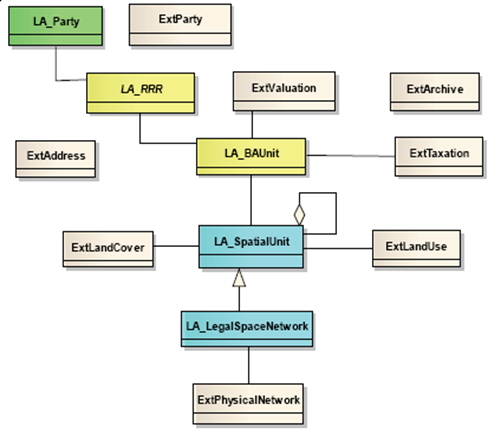 | Figure 4. LADM and External Classes [32] |
|
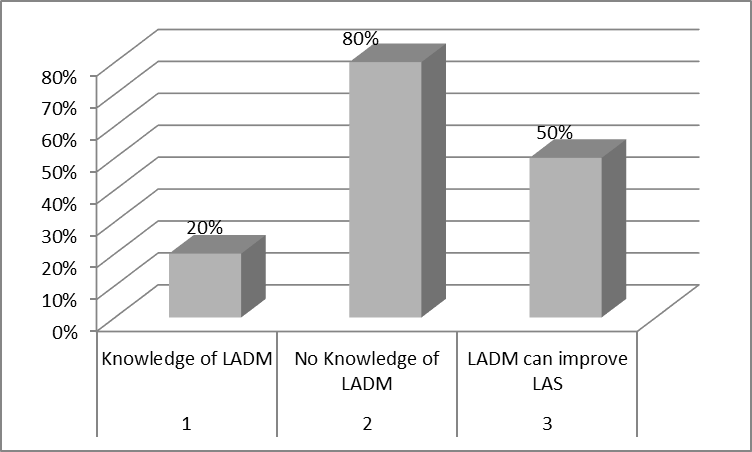 | Figure 5. The Histogram of LADM evaluation in Nigeria |
6. Analysis and Discussions
- The survey conducted between May and August 2016 in the six geo-political zones and the Federal Capital of Nigeria demonstrates that 20 percent of the respondents have caught wind of LADM with little information, 80 percent have not found out about LADM and 50 percent trusted that LADM will enhance the cadastral and land administration system of the country (table 4 and figure 6). Subsequently, for assist improvement of LADM in the study area, there is a need to conduct users` requirements, workshop, and conferences which will include the vast majority of the partner in land administration. Be that as it may, the advantages and merits of LADM adoption in the study area can't be overemphasized. LADM covers a wide range of tenures both formal and informal environment including self-composed cadastral and land administration system which is extremely regular in Nigeria because of numerous ethnic and convention the country over. It is adaptable in its execution and be adjusted to both local and the international [10]. LADM Nigerian country profile would be an advantage from the data of cadastral survey, tax collection, title registration, and land use connected together from various associations. Likewise, the spatial database joining with the literary database which is a prerequisite for the plan of land data system at all level, Local, State and the National will adequately enhance the cadastral and land administration system in Nigeria [39].The figures 6a and 6b underneath demonstrate source records and the proposed code records for surveying and Representation Sub package and Party Package while table 2 and table 3 in pervious section demonstrate the case as shown in code list respectively.
7. Conclusions
- The primary motivation for this study started from the need to build up a model in other to rouse the product applications and advancement in other to encourage the selection of land administration for manageable improvement in Nigeria. Subsequent studying of the application and the conceptualization of LADM as a kind of perspective model that has fundamental data identified with components of land administration system. There is earnest need to fundamentally investigate the conceivable outcomes of adoption of LADM in Nigeria. Likewise from this study, it was uncovered that there was no plan or model for land administration system in Nigeria. In spite of the fact that from the study conducted, LADM is not yet so prevalent among the specialist and partners in land administration in Nigeria yet, there will be high mindfulness inside couple of years with edification from the workshop, conferences and paper publications. Given this, this study begun with a record of land and land administration system in Nigeria. The exchanges was on pre-frontier, pilgrim and post-provincial time. It is done as a presentation for understanding the change required for LADM adoption in Nigeria. LADM, standard, and the packages were examined, and examination of the distinctive parts of each class and packages were made with Nigerian land administration system. In the evaluation made, it was uncovered that LADM is like the substance of Nigerian land administration and its policy. As indicated by this study, the terminologies utilized as a part of Nigerian land administration system are not the same by and large albeit some specialization might be presented and properly clarify in a rendition. Subsequently, Nigerian land administration system can embrace the standard by mapping in LADM into their system since it was found from this study the standard is appropriate for the land administration of the country. The following action will be the means by which to sort out workshops and conferences, while our next study will be the advancement of LADM country profile for Nigeria. Nonetheless, this paper can be viewed as a base for characterizing the LADM country profile for the entire Nigeria.
ACKNOWLEDGEMENTS
- The first author wish to acknowledge Ministry of Higher Education Malaysia (MOHE) and Universiti Teknologi Malaysia for funding this work GUP Tier 1 (PY/2016/06368-Vot. Number 15H61).
 Abstract
Abstract Reference
Reference Full-Text PDF
Full-Text PDF Full-text HTML
Full-text HTML